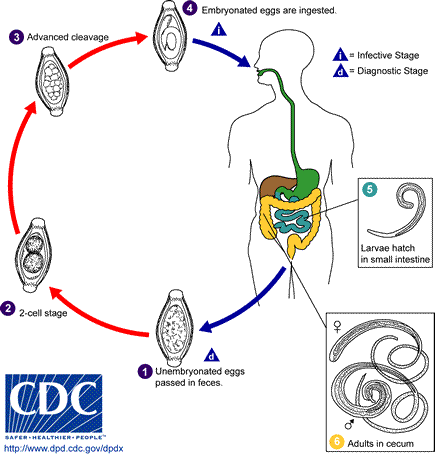Introduction to Diagnostic Medical Parasitology
Essentials
Whipworm disease is an infection of the large intestine, caused by the nematode Trichuris trichiura (the human whipworm). It is as common as Ascaris particularly in areas with poor sanitation and hygiene. Most infections are asymptomatic.

Adult worms (measuring up to 5 cm in length) have a whip-like morphology with a thinner anterior end. Eggs passed with the faeces need 2â4 weeks to become infective. After ingestion and stomach passage, the first-stage larvae hatch and temporarily penetrate the villi in the small intestine. The further development with four moults takes 1 to 3 months and occurs in the caecum and upper colon. Thousands of eggs are produced daily by the female worm which may survive for several years.

Epidemiology
- Trichuriasis has a worldwide distribution and affects approx. 800 million humans!
- Children have the highest worm burden, but older persons are also infected
- Infection is by ingestion of embryonated eggs with contaminated vegetables, soil or water
- Humans are the most important host. Animal reservoir not epidemiologically important
Pathology
- Little mucosal damage by attached worms
- Iron deficiency anaemia has been reported in heavily infected children
Clinical Findings
- Most infections are asymptomatic
- Heavy infections may cause intestinal signs and symptoms such as bloody, mucoid stools and diarrhoea, rectal prolapse, anaemia, growth retardation in children
Diagnosis
Diagnostic methods
Parasitological diagnosis
Ova of typical shape can be easily detected in faeces by concentration methods.
Microscopy is the “gold standard”!
No alternative techniques needed / available
Diagnostic strategies
Besides parasitological examinations, there is no alternative diagnostic approach available.

Prevention and control
- Sanitation: use of toilet facilities and safe disposal of faeces
- Health education
- Mass treatment in communities with high prevalence